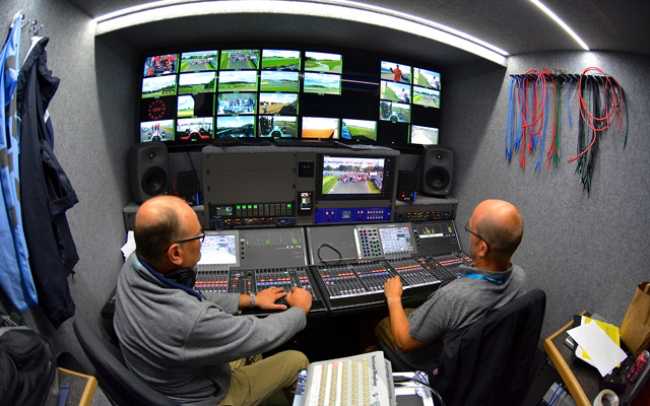FAL Systems blends Dante with Madi for Formula E
Published: ASIA

CHINA: The first event of the new FIA Formula E racing series debuted in Shanghai recently, intending to be motorsport’s highest class event for one-make, single-seater electric racing cars. Encompassing 10 city-based races across the world and televised internationally by major broadcasters including Fox Sports 1, ITV4 and CCTV, the all-new series required an all-new audio system to provide broadcast feeds. After success on previous projects, FAL Systems was enlisted by Hayfisher, which provided technical services for the series, to build a system capable of acquiring all of the A/V for the broadcast transmission.
‘Richard from Hayfisher came up with the concept about seven years ago of being able to provide TV coverage on a budget. The idea was that they would build a truck that was based around digital radio cameras,’ explained FAL Systems director, Andy Unsworth. ‘They came to us at IBC last year and knew they were going to be involved with the series, so we started discussing designs. We decided to take the design that we’d done for their trucks and make it transportable. The trucks have a very simple system running Pro1/D96s, there’s nothing clever about the way that they deal with audio, but as the Formula E project developed we had to look at a different approach. They were keen to maintain a similar design, just expand it.’
The objective was to provide a full ‘truck-like’ operational space in 2.5m by 2.5m intermodal pods. The overriding consideration was weight, but as with any new venture, budgets were tight and the system built would also have to be both expandable, and also easily replaceable/fixable should things break on the road.
Responsible for both video and audio, the team opted to deploy hybrid Miranda routers as the most cost-effective way of getting feeds back from the cameras. ‘We’d already made the decision that we were going to use this hybrid router,’ furthered Mr Unsworth. ‘We’d used it before on a previous project with another client, so we were happy with it from a reliability perspective and we knew that that was the way forward. But it spat the audio back out on Madi.’
At the time of planning Yamaha had just released the CL5 console, which ticked all the boxes for the Formula E project. The FAL team had a look over it at last year’s Plasa before agreeing it met their needs. The only downside was that it wasn’t compatible with Madi.
‘We then looked into Dante, and that was a big departure from anything that we’d done before,’ Mr Unsworth continued. ‘As far as I’m aware I don’t think, certainly from a truck perspective, that anybody is using it to the extent that we are. We looked at several other console manufacturers, all of which offered networked audio solutions. But their networked audio solutions were an additional cost on top of the console. We realised that we could buy two CL5s for the price of any other manufacturer’s console and we would get the network connectivity as standard, at no additional cost. So by the time we looked into the console, spent a bit of time with it, it became a no brainer.’
With Madi being the de facto standard for multitrack audio from a broadcast perspective, the challenge then became finding a way of interfacing the Dante network with the Madi streams from the hybrid routers. At a trade show once again, Mr Unsworth found himself at the right place at the right time.
‘We happened to be at an exhibition and walked past the Focusrite stand and noticed that they had a Dante to Madi convertor. I did a bit of research into it and decided that’s how we were going to do it,’ he added. ‘Once the three components came together; the router, the Madi convertor and the CL5s, that was it. The only addition we made was two Yamaha Rio stageboxes for the analogue I/O and a 72 x 72 Clear-Com tailback system for comms.’ A pair of Genelec 8020s and a Bel BM-Ai-16SHD provided metering and monitoring.
The team ended up deploying four Focusrite Rednet 6 Madi to Dante convertors, more than enough to handle the 120 channels of audio they had predicted would be required. ‘We did that for two reasons,’ explained Mr Unsworth. ‘Firstly, it made it very expandable very easily, but second there was the redundancy element there, so if we have one of the Dante interfaces fail, there’s plenty of capacity for things to be transferred.’
The hope is that the series will go on to be highly popular, and with the first race completed in crashing style, it has every indication that it will. If it does continue to expand, the audio system designed can easily scale up with the addition of more broadcast-specific consoles. The series now moves on to the next race in Malaysia and for the equipment, that simply means packing up the pods and moving on.
